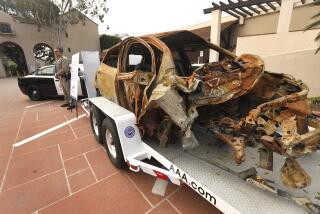Gadgets Should Be Heard but Not Seen
- Share via
Question: When I’m driving my Audi A4 and have the radio on, I’m troubled by the fact that not only do I have to listen to advertisements, but I also see them scrolling across display monitors in my car.
The vehicle’s Radio Data System displays printed messages and text that identifies the radio station and the names of songs and recording artists. There’s a monitor on the stereo faceplate and one located between the odometer and tachometer on the dashboard.
If I had the option, I’d get rid of this standard feature in a heartbeat. It’s distracting. I’m a good driver, but I’m embarrassed to admit that on occasion I’ve spent so much time trying to decipher the messages that I’ve taken my eyes off the road.
--C.M., Rancho Cucamonga
Answer: Scrolling messages and ads from the Radio Data System certainly could lead to distraction if you’re more focused on the monitors than on the road. You can avoid the visual annoyance by switching off the message and text feature on the car radio system.
Still, the concerns you raised make me wonder how many drivers are out there cruising around with eyes glued to RDS monitors. The systems are becoming increasingly popular, especially in high-end vehicles. Cadillac, for example, also offers RDS as standard equipment in some models.
The risk of driver distraction by an RDS feature is similar to the danger posed by improper use of other electronic gadgets and gizmos. The use of cell phones, Internet service and entertainment centers can impair a driver’s concentration, safety advocates warn.
Features such as DVD players and video games can be especially distracting if the screens are mounted so they can be viewed by drivers. Even navigation systems that require drivers to study maps on a monitor can dangerously divert their attention.
There is no federal legislation restricting the use of such systems in vehicles, said Liz Neblitt, a spokeswoman for the National Highway Traffic Safety Administration in Washington.
The agency does, however, warn drivers not to engage in behavior that could distract them behind the wheel. In fact, research by the agency and groups including AAA has shown that 25% to 50% of the 6.5 million crashes reported in the U.S. each year involve some form of distraction or inattention.
The lack of federal legislation has prompted some states to come up with restrictions of their own to ensure safety.
In California, video or television screens, by law, cannot be installed in the front-seat portion of a vehicle within view of the driver, said Anne Da Vigo, a spokeswoman for the California Highway Patrol in Sacramento.
Nevertheless, Californians are able to drive vehicles equipped with flip-down screens viewable by front-seat passengers. Aftermarket players and monitors also are allowed as long as they are not visible to the driver.
With the growing popularity of all this technology, said auto safety advocate Rosemary Shahan, the traffic safety administration needs to step in and “exert some authority in this arena.”
“It’s totally irresponsible for auto manufacturers to design in ads that compete for your eyeballs while you’re busy navigating in heavy traffic,” said Shahan, president of Consumers for Auto Reliability and Safety in Sacramento.
“Driver distraction is a serious problem that contributes to many crashes,” she said. “Manufacturers have shown they don’t know where to draw the line.”
But industry sources say that auto makers are taking the issue of driver distraction seriously and that many manufacturers have launched studies to make the technology safer.
General Motors Corp., for instance, announced this year that it would spend $10 million over three years to determine the safest way to equip vehicles with communication devices, said Jim Spoonhower, vice president for market research at the Specialty Equipment Market Assn.
Ford Motor Co. has spent millions of dollars to address the distraction factor, said Spoonhower, whose Diamond Bar-based trade group represents the $26-billion-a-year auto aftermarket industry.
As a result of such research, auto makers are trying to make vehicles safer by pushing voice activation and hands-free technology in vehicles, Spoonhower said.
At some point, he predicts, video-based devices will be designed to be inoperable in the front seat when a vehicle is in motion. It will happen whether it’s legislated or manufacturers agree “to do it for safety sake.”
“The idea,” he said, “is the driver can’t be distracted.”
Clarion, a major maker of mobile multimedia equipment, markets a system called Joyride that incorporates a DVD-CD-MP3 player and a navigation system.
By applying voice activation and touch-screen command features on such products, the company is responding to drivers’ desire for safer ways to use the high-tech systems in their vehicles, said Melissa Low, a company spokeswoman.
Auto entertainment and navigation systems have great appeal to many families who have children and want products that are “cool but also safe,” she said.
In 2001, the market for mobile video-navigation equipment was estimated at $700 million. That was up from $500 million in 2000, the Specialty Equipment Market Assn. said.
The bottom line seems to be that many people who can afford this technology crave it. But we need to remember that the more gadgets we accumulate in our vehicles, the higher the risk of distraction.
*
Jeanne Wright cannot answer mail personally but responds in this column to automotive questions of general interest. Write to Your Wheels, Business Section, Los Angeles Times, 202 W. 1st St., Los Angeles, CA 90012. E-mail: jeanrite @aol.com.






